|
Pakistan, a Federal Parliamentary Islamic Republic with more
than 176 million people, consists of four Provinces (Balochistan, Khyber
Pakhtunkhwa, Punjab, and Sindh) and four federal territories (Islamabad
Capital Territory, Federally Administered Tribal Areas [FATA], Azad
Jammu and Kashmir, and Gilgit-Baltistan; (Government of Pakistan, 2011).
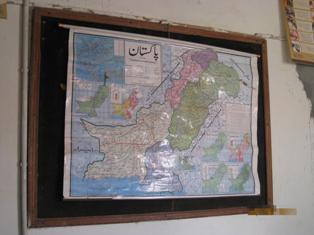
Classroom Map of Pakistan
Pakistan is a heterogeneous country with many religious,
cultural, linguistic, and ethnic groups and is socioeconomically,
educationally, geographically, and ecologically diverse. The country is
one of 19 with high linguistic fractionalization, one of 11 with high
fragility and conflict levels, one of 34 less developed with large rural
population (Pinnock, 2009) and the 145th of the 187 countries with low
human development (UNDP, 2011). These figures present a tremendous
asset, an opportunity, and a necessity for the republic to practice
inclusion, tolerance, and acceptance. However, this very diversity and
the ways it has been dealt with have often challenged the country, which
suffers from historical hostility between and among groups resulting in
state fragility, conflict, and insurgency.
Although Article 25A of the 18th Constitutional Amendment
(2010) calls for free and compulsory education for all 5- to
16-year-olds and puts the sole responsibility for this on the state, in
2012, 23% (rural) and 7% (urban) 6- to 16-year-olds were not in school
(ASER, 2012, p. 8). One in 10 out-of-school children live in Pakistan
and by 2015 there will still be more than six million out-of-school
children in the country (UNESCO, 2011, p. 42).
Of those enrolled in school very few are actually learning.
Student achievement is falling significantly below the standard
curricular levels, with more than 50% of fifth graders not able to cope
with second-grade basic literacy and numeracy skills (ASER, 2012). For
example, in 2012, more than 64% of fifth graders in Balochistan were not
able to carry out a third-grade-level division sum and more than 11% of
10th graders in FATA were not able to read a second-grade story in Urdu
or Pashto. Learning levels are “alarmingly” different between males and
females across all socioeconomic levels, with the exception of girls
who come from the richest income group (ASER, 2012, p. 22). Illiteracy
levels in the country are dire and the most vulnerable populations are
children who are linguistically diverse (UNESCO, Misselhorn, Harttgen,
& Klasen, 2010).
In contrast to this extreme education poverty, the people of
Pakistan have a rich linguistic repertoire with about 61–72 languages
spoken in the country. A majority of Pakistanis speak or understand more
than two languages (Lewis, 2009; Rahman, 2010). About 44% of the
population speaks Punjabi, followed by Pashto (15%), Sindhi (14%),
Seraiki (10%), Urdu (7.6%), and Balochi (3.6%). Other major languages
spoken are Hindko, Kashmiri, Khowar, Kohistani, Brahui, Baryshaki,
Arabic, Dari, Persian, and Turkic.
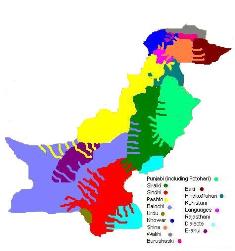
Linguistic map of Pakistan; Source: Fred Bolor, 2009
For historical, political, and other reasons Urdu has prevailed
as the national language and along with English—the former colonial and
now official language—have been promoted in schools. Urdu is the mother
tongue of only about 8% of the population, yet it is widely used
nationwide, although in some provinces “there is a certain degree of
hostility towards the national language” (Coleman & Capstick,
2012, p. 15). The proponents of teaching in Urdu argue that one language
is essential to maintaining national unity, and this issue has been an
important contributing factor to the Sindhi nationalism and the Balochi
insurgency.
Unfortunately, 91% to 95% of the country’s children have no
access to education in their mother tongue, making Pakistan one of 44
countries facing the same issue (Coleman, 2010; Pinnock, 2009; Walter,
2009).
Language Policy and Practice in Education
Since 1947, language-of-instruction mandates have changed many
times—all failing to formulate a clear, sustainable, and effective
policy. The most recent national education policy was developed in 2009.
This policy addressed the issue of language of instruction, suggesting
that English be taught as a subject from first grade onward and Urdu and
one regional language be included in the curriculum. Starting in fourth
grade, science and mathematics should be taught in English only.
The policy does not take into consideration that the vocabulary
and cognitive processes involved in teaching and learning a language as
a subject with actually teaching and learning a content area through a
second language differ greatly in intensity, vocabulary, and methodology
(Ball, 2011; Chamot & O’Malley, 1986; Coleman, 2010; Coleman
& Capstick, 2012; Fleming, 2006). It makes no clarification
about the medium of instruction in primary schools and gives no
guidelines for policy implementation to the provincial authorities. And
as the power has been returned to the provinces, making them responsible
for policy formulation and sector financing, only sporadic and
unsystematic efforts across the provinces to develop
language-of-instruction policies have been observed.
Thus, in Sindh, Sindhi is the only provincial language that is
used in lower administration, judiciary, and education. Yet, although
the medium of instruction in public schools is Sindhi (97%), Urdu (2%),
and English (1%; ASER, 2012, p.18), linguistically diverse children in
several areas of the province are still denied a meaningful education by
the exclusion of their mother language in school (Rafiq,
2010).
In Punjab, the country’s most populous province, with about 100
million people, the popular but unfortunate English Language Initiative
emerged recently and has been implemented in public schools. The medium
of instruction in public schools is English (50%) and Urdu (50%; ASER,
2012, p. 18), textbooks are now printed in English and primary and
secondary teachers are urged to use it as the medium of instruction.
Yet, although the majority of teachers are not fluent in English or do
not speak it at all, it is expected that after two weeks of language
training, they should be able to teach effectively in English to
children whose mother tongue is Punjabi or another provincial language.
In Khyber Pakhtunkhwa there is greater awareness and
appreciation of the diversity of the provincial languages and of the
benefits of instruction in the mother tongue. The government, with the
support of development partners, initiated an effort to standardize the
alphabets of Seraiki, Khowar, Kohistani, and Hinko while involving local
communities, experts, poets, writers, religious leaders, and other
stakeholders. This effort led to the Mother Tongue Education Bill (2011)
according to which, from 2012–2013 and in the areas they are spoken,
the regional languages are to be taught as compulsory subjects in Grades
1–7 and by 2017–2018 in Grades 8–12. However, this policy has not been
implemented as intended. The medium of instruction is Urdu (66%), Pashto
(30%), and English (3%; ASER, 2012, p. 18).
In Balochistan, although Balochi is spoken by the majority of
the population in the province, it is not the official language, and
Urdu is the medium of instruction in 100% of the government schools
(ASER, 2012, p. 18). Balochi is taught at the University of Balochistan
in Quetta, at the Balochi Academy, and is used in radio, television, and
publications. It was introduced in the 1990s as the language of
instruction in primary schools, but the policy was short-lived primarily
because of negative attitudes toward the language and disagreements on
its proper orthography and use (Jahani, 2004). In FATA, government
schools use Urdu (80%), Pashto (17%), and English (2%); in Gilgit
Baltistan, Urdu (68%) and English (32%); and in Azad Jammu and Kashmir,
Urdu (97%) and English (3%; ASER, 2012, p. 18).
Language of Instruction and the Curriculum
In Pakistan the curriculum and language of instruction vary
depending on the type of school, the province, or federal territory. The
elite private schools, the schools run by the armed forces, and many of
the low-cost private schools use English. Of the 41 home languages
recorded by ASER, only Sindhi, Urdu, Pashto, and English are used in
government schools (ASER, 2012; Coleman & Capstick, 2012). The
religious schools, the Madrasas (or
Madaris) use varying media, including Arabic and are usually
the schools of the very poor.
The last national education curriculum was developed in
2006–2007 and set language learning standards for Urdu and English but
not for other Pakistani languages. It was developed under the auspices
of the Federal Ministry of Education, Curriculum Wing (now abolished
with the 18th Amendment) in collaboration with UNESCO, the Education
Sector Reform Assistance Program, experts, educators, and other
stakeholders. It has been largely debated and although initially adopted
by the provinces, it will eventually be abandoned as a consequence of
the devolution.
The 2006–2007 curriculum claimed to be focused on student
learning outcomes and based on the principles of inclusion,
nondiscrimination, tolerance, acceptance of diversity, gender equity,
responsible citizenship, promotion of peace, and avoidance of extremism,
war, and radicalization. However, there is a mismatch between its
principles and its practices. Textbooks do not reflect the colorful
mosaic of the diverse languages, cultures, or religions of the country.
Lessons portray only Muslim heroes and do not include minorities or
women heroes, artists, scientists, and poets. Women and girls are
presented assuming traditional roles at home. Many lessons are about
nationalism and glorifying wars, and very few link religion,
nationalism, and peaceful coexistence.
The majority of first- and second-grade textbooks are
unsuitable for young children—especially those whose mother tongue is
different from the language of instruction. They have long passages,
complex texts and layouts, and the texts written in Urdu use the
Nasta-liq script (the “cursive” nonlinear form of Arabic), which makes
it very difficult for young learners to become readers. This puts
children from linguistically diverse and poor households at a great
disadvantage.
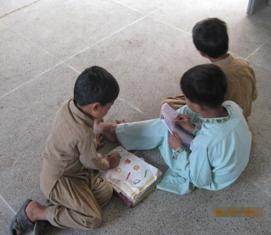
First Grade Students Copying from The Board
Literacy attainment becomes more difficult when schools have
very limited resources. Teacher and student absenteeism hits government
schools like a plague. It is estimated that about 13% of teachers and
18% of students (in Sindh 40%) are absent on a daily basis (ASER, 2012,
p. 8). “Ghost teachers,” teachers no one has ever seen, are on the
payroll; corporate punishment is present, and, in some cases, children
suffer serious or fatal injuries as a result. In some areas,
parents—especially those of girls—are reluctant to send their children
to school because they find the curriculum irrelevant to their own
culture, the school has no boundary walls or sanitation facilities, or they fear
that extremist religious groups may threaten their families’ lives and
safety.
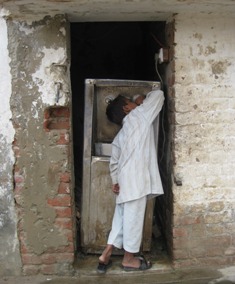
School Fountain
In Punjab, the top-down monitoring system implemented by the
government to monitor schools’ compliance with existing mandates is
called the Roadmap (see picture below).
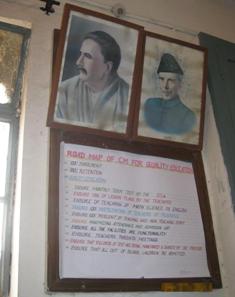
This approach helped improve several quantitative indicators,
such as teacher presence in class, preparation of daily lesson plans,
and dissemination of textbooks. However, a heavier emphasis must be
placed on qualitative indicators such as lesson quality and relevance,
language of instruction, and effectiveness of instruction and
assessment. Submitted lesson plans, for example, are done for the most
part to pass inspection requirements without much substance or
pedagogical appropriateness.
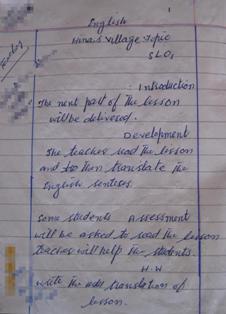
Approved Lesson Plan
Therefore, monitors visiting the schools to record compliance
must be knowledgeable and well-trained educators to adequately evaluate
lesson plans and classroom practices.
Conclusion
The development of specific policies and practices to address
the issues of language of instruction and effective teaching for the
poor is critical to engage and retain more children in school who are
actually learning, as well as in tackling the education emergency in
Pakistan. Individuals’ right to education can be actualized when
policies are based on learning theory and research, and are designed not
for their popularity but for their effectiveness and sustainability.
The education of culturally and linguistically diverse children must be
considered from a holistic point of view, actively involving parents,
families and communities, all in the context of Pakistan’s
sociocultural, ethnic, economic, and political complexity as well as the
security situation in the country.
Tackling illiteracy and teaching children how to read and write
in the primary grades in a language they speak and understand must be
education’s primary focus. Instructing children in “broken” English from
teachers who do not speak the language themselves only perpetuates
illiteracy’s vicious cycle and gives false hopes to millions of families
who dream of a better life for their children. Parents and stakeholders
must be made aware that instructing children in a language they speak
and understand will not only improve the latter’s knowledge in the
content areas; it will also help them learn other languages (e.g., Urdu,
English) efficiently and effectively (Patrinos & Velez, 1996).
Addressing issues related to quality of teaching, such as lack
of accountability, teacher absenteeism, and systemic corruption in
education, and creating safe and child-friendly schools for all girls
and boys are central to any educational reform in Pakistan. Teacher
education and professional development must focus on improving
instructional and assessment practices for culturally and linguistically
diverse students, and a comprehensive education policy must address the
language of instruction as one of the most essential contributors to
children’s learning in this challenging country.
References
ASER. (2008). Annual status of education
report (rural): ASER-Pakistan 2008.
Retrieved from http://www.aserpakistan.org/document/aser/Aserpak2008.pdf
ASER. (2012). Annual status of education
report (national): ASER-Pakistan 2012.
Retrieved from http://www.aserpakistan.org/document/aser/2012/reports/national/National2012.pdf
Ball, J. (2011). Enhancing learning of children from
diverse language backgrounds: Mother tongue based bilingual or
multilingual education in the early years. Paris, France:
United Educational, Scientific, and Cultural Organizations.
Chamot, A. U., & O’Malley, J. (1986). A
cognitive academic language learning approach: An ESL content based
curriculum. Wheaton, MD: National Clearinghouse for Bilingual
Education.
Coleman, H. (2010). Teaching and learning in Pakistan:
The role of language in education. Islamabad, Pakistan:
British Council. British High Commission.
Coleman, H., & Capstick, T. (2012). Language
in education in Pakistan: Recommendations for policy and
practice. Islamabad, Pakistan: British Council.
Fleming, M. (2006). The teaching of language as school
subject: Theoretical influences. Strasbourg, France: Council
of Europe.
Government of Pakistan. (2011). Population census
organization. Islamabad, Pakistan: Ministry of Economic
Affairs and Statistics, Statistics Division. Retrieved from http://www.census.gov.pk
Jahani, C. (2004). State control and its impact on
language in Balochistan. In A. Rabo & B. Utas (Ed.), The role of state in East Asia. Stockholm, Sweden:
Swedish Research Institute in Istanbul. Retrieved from http://www2.lingfil.uu.se/personal/carinajahani/jahani-red.pdf
Patrinos, H., & Velez, E. (1996). Costs and
benefits of bilingual education in Guatemala: A partial
analysis (Human Capital Working Paper No. 74). Washington, DC:
World Bank Group.
Pinnock, H. (2009). Language and education: The
missing link. Reading, England: CfBT Education Trust and Save
the Children.
Rafiq, G. R. (2010). Language policy and education in
Sindh, 1947–2010: A critical study. Santa Barbara: University
of California.
Rahman, T. (2010). Language policy and localization in
Pakistan: Proposal for paradigmatic shift. Retrieved from http://www.apnaorg.com/research-papers-pdf/rahman-1.pdf
UNDP. (2011). Sustainability and equity: A better
future for all. New York, NY: Author. Retrieved from http://hdr.undp.org/en/media/HDR_2011_EN_Contents.pdf
UNESCO. (2011). The hidden crisis: Armed conflict and
education. Paris, France: Author. Retrieved from http://unesdoc.unesco.org/images/0019/001907/190743e.pdf
UNESCO, Misselhorm, M., Harttgen, K., & Klasen, S.
(2010). Deprivation and marginalization in education.
Paris, France: Author. Retrieved from http://www.unesco.org/new/fileadmin/MULTIMEDIA/HQ/ED/GMR/html/dme-5.html
Walter, S. (2009). Language as a variable in primary
education. Arlington, TX: SIL International.
Dr. Eirini Gouleta is associate professor of
international education and interim academic program coordinator of the
Multilingual Multicultural Education programs at the Graduate School of
Education, George Mason University, in Fairfax, Virginia. She has work
and research experience in education development and in Pakistan, where
she served as a senior education adviser and team leader for the
provincial delivery of education for the U.K. Department for
International Development. |

